|
-
Squeaky clutch fix - clutch slave cylinder service
Disclaimer: The following is provided as a GUIDE ONLY, and neither myself nor Ozhonda take any responsibility for the outcomes of someone else doing the following. You follow these steps at your own risk!
Aim: To fix a squeaky clutch pedal by servicing the clutch slave cylinder
Required:
Lithium based grease or super high temp urea + rubber grease
12mm spanners/sockets
10mm spanner
Blu tack
8mm spanner
Honda brake fluid
Plastic tubing and collection container
Firstly:
Firstly and most importantly, confirm the source of your squeaky pedal problem. Depress the clutch pedal by hand and listen in the driver's footwell to see if the sound originates from there. If not, get a friend to push on the clutch pedal whilst you listen in the engine bay. If it's coming from the engine bay, you might be able to narrow it down to the clutch slave cylinder, located on the front of the gearbox, adjacent to the radiator fan (pictured below). If this is the source of the noise, continue reading, this DIY is for you.
Mine sounded like a creaking door when the clutch pedal was pressed, and a sharper squeak when released. Vehicle used here is '00 DC2R. Should be a pretty similar process on other Hondas.
Steps:
Remove the clutch slave cylinder.
Crack the two 12mm bolts which hold the slave cylinder to the gearbox (located underneath the cylinder).
Using a 10mm spanner, loosen the nut which holds the metal hydraulic line to the top of the slave cylinder. Fluid will start leaking out - try to catch it using a rag.
Remove the two 12mm bolts you cracked earlier, and loosen the hydraulic line nut until the hydraulic line can be removed from the slave cylinder. Put a piece of blu tack or similar over the end of the line to try and limit fluid loss. Be careful with where the fluid goes as it can damage paint.
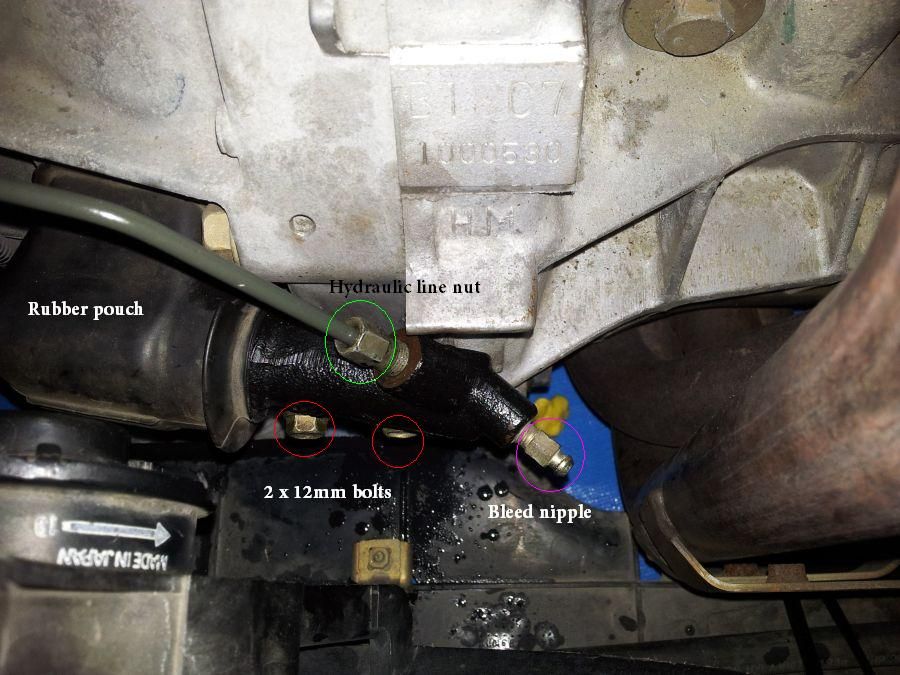
The slave cylinder should now be free of all connections. To remove it completely, gently pull it to the right until it slides out of the rubber pouch connected to the gearbox.
Inspect the ball head on the end of the push rod, which sticks out the end of the crinkled rubber boot. Mine was a bit rusty and devoid of grease, but reasonably smooth and in otherwise good condition. If yours is pitted it may need replacing. Put to the side.
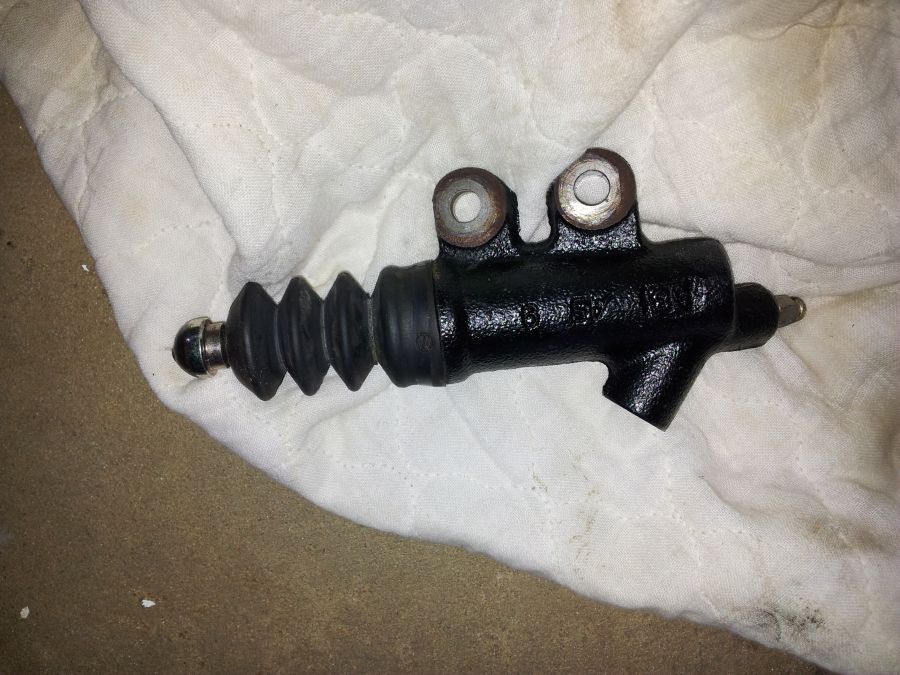
After removing the slave cylinder, you are left with a flexible rubber pouch sticking out to the side of the gearbox. By gently prying up the sides of it where it joins the box with your hands, you can remove it revealing the metal arm underneath (pictured).
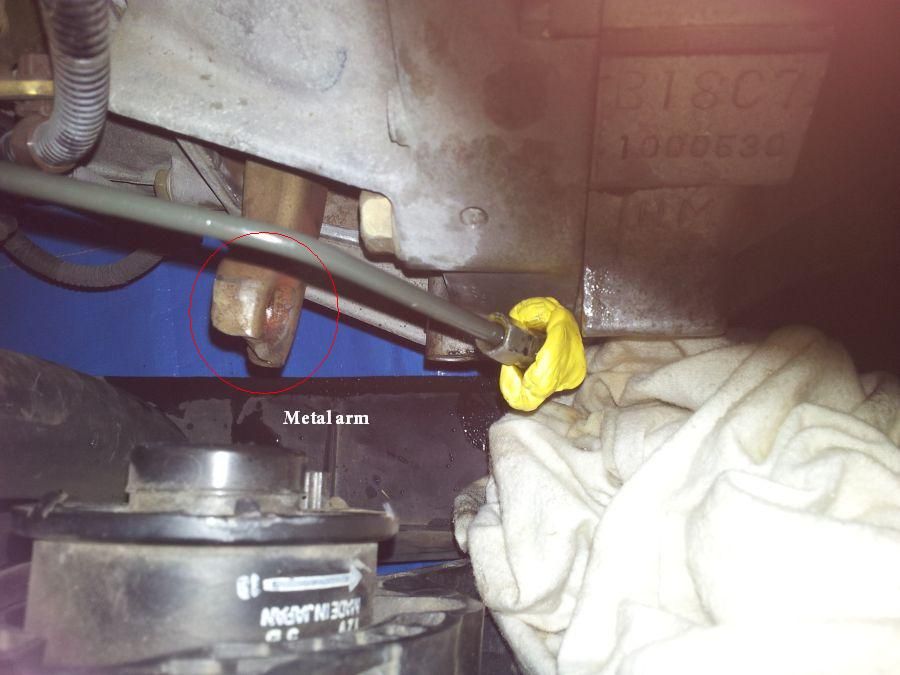
Using a clean rag and a dash of turps, clean up circular depression on the gearbox metal arm which houses the push rod, and the ball head on the end of the slave cylinder. I got dirty old grease and rusty residue off mine.
Get some of your grease and apply a generous amount to the ball head and its mate on the metal gearbox arm. Be careful at this stage not to contaminate the grease or any of the components with clutch fluid residue that's been spilt around - it will dissolve the grease and decrease its effectiveness. Honda recommend some specific greases for the job (below). I used lithium-based grease as it's benign and all I had on hand. Time will tell if it holds up to higher temperatures.
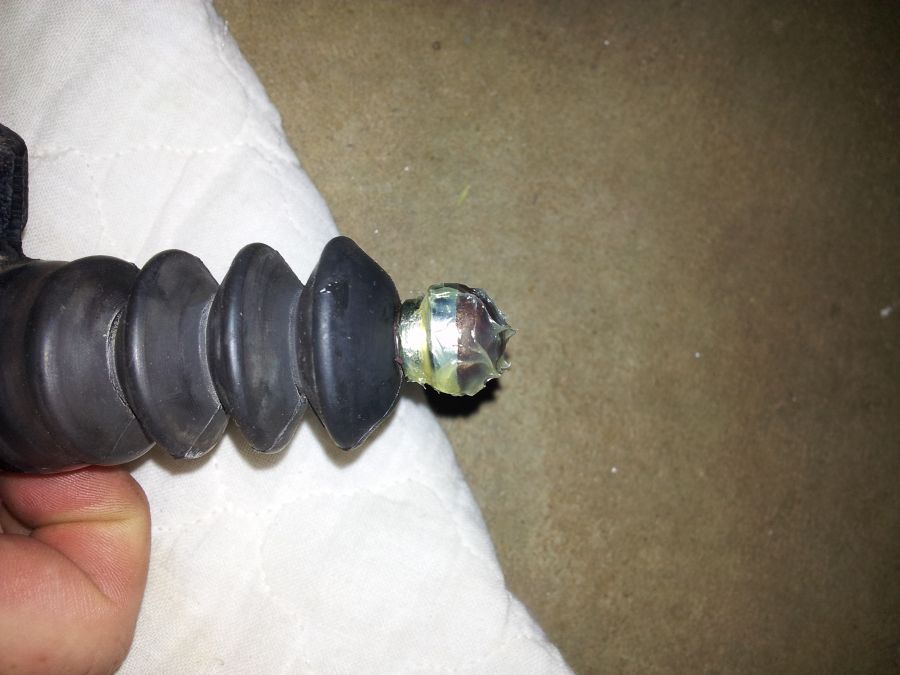
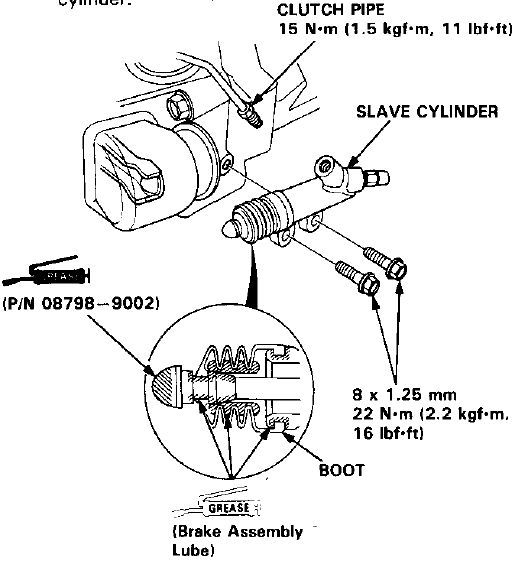

Carefully reinstall the rubber pouch back over the gearbox. Get the slave cylinder, and push the push rod end all the way back into the rubber gearbox pouch. Hand insert the hydraulic line, hand tighten the nut, and hand tighten the two 12mm bolts which connect it to the gearbox. Check everything is lined up properly, then tighten everything up. Torques are shown on above image.
Note:
After completing the above you will most likely have to bleed your clutch fluid, due to the fluid loss. There are other DIYs around that explain how to do this. As a quick guide, connect some plastic tubing to the end of the slave cylinder nipple and put the other end in a collecting container. Get a friend to sit in the car. Crack the bleed nipple and get your friend to push the clutch pedal in. Close the bleed nipple and get him to release the pedal. Watch the fluid level in the clutch fluid reservoir go down, and keep filling it with Honda brake fluid before it drops below the bottom of the reservoir. Continue this process until 1) you get fluid coming out of the nipple and into the tubing (might take a while due to the fluid loss) and 2) you no longer see air bubbles passing out of the nipple inside the fluid and you see your new fluid coming out the nipple (if you want to do a full fluid flush).
Tighten everything up, go for a test drive, and enjoy your silent pedal  If this doesn't solve the sound, the problem may be at the drivers feet or related to something different (like the throw out bearing). If this doesn't solve the sound, the problem may be at the drivers feet or related to something different (like the throw out bearing).
Cheers!
Last edited by rhys.l; 02-04-2013 at 07:40 PM.
-
Good DIY! and yes, the clutch will DEFINITELY need to be bled afterward.
A note to add here though is that a lot of the time the squeak actually comes from the pivot point on that the actuator fork is mounted to inside the gearbox, which as far as I know cannot be accessed without removing the gearbox itself.
But this is the point to start!
-ZAMMIN-
"I know who you are, and I know if I make a formal complaint Mr. Benjamin will have to roll over and give me all your details" - Integra-GSi 19/11/2015
-
 Originally Posted by Super-DA9

Good DIY! and yes, the clutch will DEFINITELY need to be bled afterward.
A note to add here though is that a lot of the time the squeak actually comes from the pivot point on that the actuator fork is mounted to inside the gearbox, which as far as I know cannot be accessed without puttind a grease gun in there and just filling the bell housing, this is what honda recomend,trust me.
can i just use wd40?
Mate my bbk cost more than your Honda.
-Amant02
-
 Originally Posted by Daveho1

can i just use wd40?
I tried WD40 plenty of times...
The thing with WD40 is that it gets washed off easily. Grease is more water resistant.
-
read the above post, it was a joke.
Mate my bbk cost more than your Honda.
-Amant02
-
 Originally Posted by Super-DA9

A note to add here though is that a lot of the time the squeak actually comes from the pivot point on that the actuator fork is mounted to inside the gearbox, which as far as I know cannot be accessed without removing the gearbox itself.
But this is the point to start!
I came across a post on another forum where someone reckoned you could get to that by greasing up your fingers and sticking them through the small opening in the gearbox. Pretty hit and miss I'd imagine. I gave it a go anyway and something in there copped a bit of grease!
Grease on the slave is holding up well so far!
-
nice work. i did this yesterday but the gear box was out so lots easyer lol. inside the box the throw out fork is cliped onto another ball pivot which needs lubrication aswell however it would be a safe bet to do this when the box is out only as there is the chnce that if you where to service that pivot the throw out fork may pull away from the throw out bearing then you would have to remove the box anyway lol.
Mate my bbk cost more than your Honda.
-Amant02
-
Starting to get a bit of noise again after 3 months/1000km. Going to buy some moly disulfide grease and have another go. This grease should hold up better under high temp and the moly component should still provide some lubrication even when most of the base grease has been pushed to the side.
-
 Originally Posted by rhys.l

Starting to get a bit of noise again after 3 months/1000km. Going to buy some moly disulfide grease and have another go. This grease should hold up better under high temp and the moly component should still provide some lubrication even when most of the base grease has been pushed to the side.
If it still squeaks after that then it's most likely a lack of grease on the pivot ball that the clutch fork sits on inside the bell housing of the gearbox.
-ZAMMIN-
"I know who you are, and I know if I make a formal complaint Mr. Benjamin will have to roll over and give me all your details" - Integra-GSi 19/11/2015
-
I was starting to suspect that, but all is quiet again after the slave regrease with the new stuff. Fingers crossed it stays this way for a little longer this time.
What do you have to do if it's the pivot ball inside the bell housing? Take the gearbox off? 
-
 Originally Posted by rhys.l

What do you have to do if it's the pivot ball inside the bell housing? Take the gearbox off? 
Yeah man thats right. gearbox gotta come off. better to just live with the squeak until you upgrade the clutch or something haha.
-ZAMMIN-
"I know who you are, and I know if I make a formal complaint Mr. Benjamin will have to roll over and give me all your details" - Integra-GSi 19/11/2015
-
Still going well. This stuff is what you want

 Posting Permissions
Posting Permissions
- You may not post new threads
- You may not post replies
- You may not post attachments
- You may not edit your posts
-
Forum Rules
|
If this doesn't solve the sound, the problem may be at the drivers feet or related to something different (like the throw out bearing).










 Reply With Quote
Reply With Quote



Bookmarks